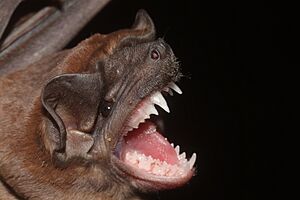Sinaloan mastiff bat facts for kids
The Sinaloan mastiff bat (Molossus sinaloae) is a type of bat that belongs to the Molossidae family. These bats are found in Mexico, Central America, and the northern parts of South America.
Quick facts for kids Sinaloan mastiff bat |
|
|---|---|
 |
|
| Conservation status | |
| Scientific classification | |
| Genus: |
Molossus
|
| Species: |
sinaloae
|
 |
|
| Sinaloan mastiff bat range | |
Contents
About the Sinaloan Mastiff Bat
The Sinaloan mastiff bat is a medium-sized bat. It measures about 11 to 14 centimeters (4.3 to 5.5 inches) long. Its wings can spread up to 33 centimeters (13 inches) wide. An average bat weighs about 24 grams (0.8 ounces).
Its fur is long and soft. The fur on its back and upper body is blackish or dark brown. This color fades to a medium brown on its belly. The bat has a fairly narrow head and a long snout. Its front teeth, called incisors, look like pincers.
Male bats are usually bigger than females. However, you cannot tell them apart just by looking at their skulls. Males also have special scent glands on their throats. These glands make a thick, oily fluid that has a strong smell. These glands are biggest and most active from May to August. This is around the time when female bats give birth.
Where Sinaloan Mastiff Bats Live
The Sinaloan mastiff bat lives in western Mexico, starting from Sinaloa and going south. It is also found in the Yucatán Peninsula, across Central America, and in Trinidad. You can also find them from northern Colombia all the way to The Guianas.
These bats live in two main types of forests. They can be found in dry forests where trees lose their leaves. They also live in tropical evergreen forests, where trees stay green all year. They usually live below 1,000 meters (3,300 feet) in elevation. Sometimes, they can be found as high as 2,400 meters (7,900 feet).
Scientists recognize two different groups, called subspecies:
- M. s. sinaloae: This group lives from Mexico down to Costa Rica.
- M. s. trinitatus: This group lives in Panama, South America, and Trinidad.
Sinaloan Mastiff Bat Life and Habits
Sinaloan mastiff bats mostly eat moths. Moths make up about 78% of their diet. They also eat a lot of beetles and bugs. Sometimes, they eat other flying insects too.
These bats sometimes rest in caves. But they are more often found sleeping in palm trees. They also like to rest in cracks or holes in buildings and other human-made structures. A group of these bats, called a colony, can have up to one hundred bats.
However, individual resting spots are usually home to either a single male bat or a group of bats of the same sex. Groups made up only of females are often visited by males.
Reproduction and Life Cycle
Sinaloan mastiff bats usually breed between March and April. The baby bats are born about three months later. Most of the time, a female bat will have only one baby. About 5% of the time, they will have twins.
Baby bats stop drinking their mother's milk when they are six to eight weeks old. Female bats can start having their own babies when they are about one year old.


